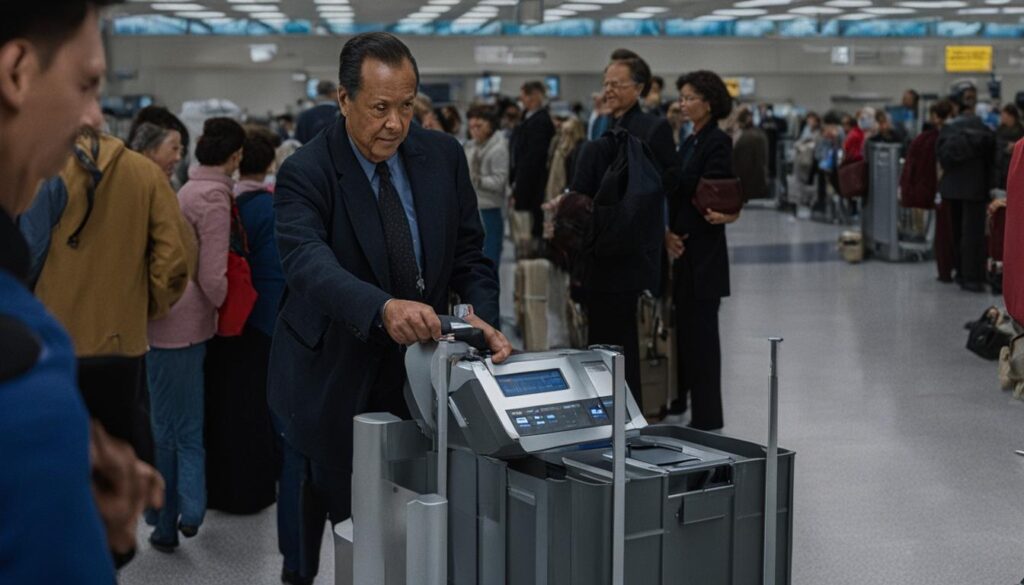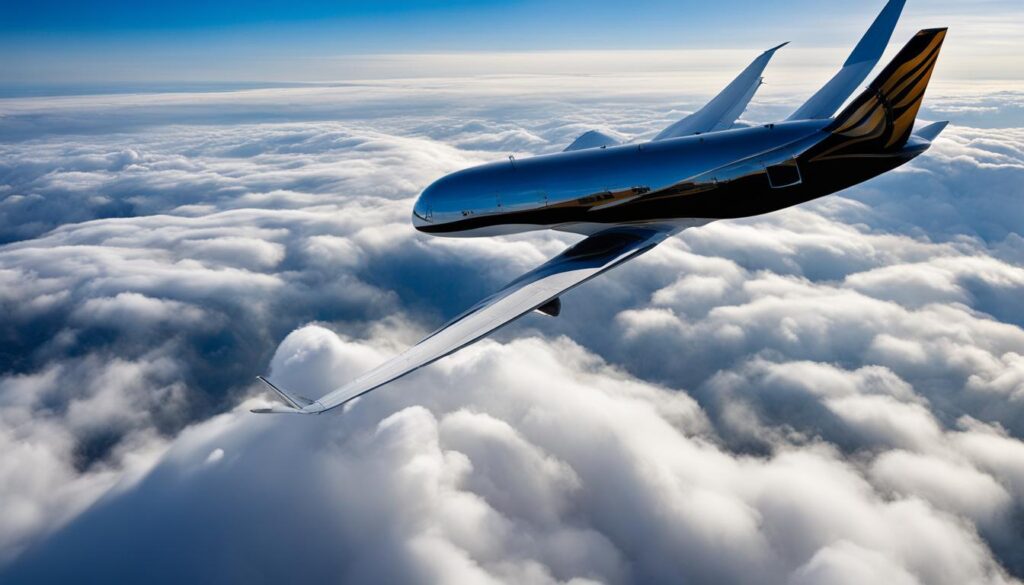Are you wondering if you can bring a radio on a plane? Whether you’re a music lover or simply want to enjoy some entertainment during your flight, it’s important to know the rules and regulations regarding bringing radios on planes. In this air travel guide, I will explore the guidelines you need to know so you can plan your trip accordingly.
While it’s generally allowed to carry a radio on a plane, you need to be aware of certain restrictions and regulations that may apply. Different types of radios have different guidelines concerning their usage and frequencies, and they are also subject to specific screening procedures by TSA security officers. By following the guidelines and tips mentioned in this guide, you can bring your radio on a plane safely and conveniently.
Key Takeaways:
- Bringing a radio on a plane is generally allowed, but subject to specific rules and limitations.
- Different types of radios may have varying restrictions regarding their usage and frequencies.
- TSA security officers will subject your radio to specific screening procedures at the airport security checkpoint.
- There are alternative options available if bringing a radio on a plane seems inconvenient or impractical for your travel needs.
- By following the guidelines and tips mentioned in this guide, you can ensure a safe and smooth journey while enjoying your radio during the flight.
Radio Regulations on Planes
When it comes to bringing my radio on a plane, it’s important to understand the regulations set by authorities to avoid any potential issues during my travels.
According to FAA regulations, radios are allowed on airplanes, but they must be stowed away during takeoff and landing since they can interfere with the plane’s communication systems.
However, the type of radio allowed on planes can vary depending on the airline and the country you’re traveling to. Some airlines may have specific restrictions on the type and number of radios allowed per passenger. It’s recommended to check with the airline before packing your radio to avoid any surprises at the airport.
| Type of Radio | Allowed on Plane? |
|---|---|
| AM/FM Radio | Yes |
| Shortwave Radio | Yes, but may be subject to additional screening |
| CB Radio | Not allowed |
| Handheld Transmitter | Not allowed |
As seen in the table above, not all types of radios are allowed on planes. CB radios and handheld transmitters are typically not permitted as they can interfere with the plane’s communication systems. Meanwhile, AM/FM and shortwave radios are generally allowed but may be subject to additional screening.
It’s also important to note that the use of radios that transmit or receive certain frequencies is restricted on planes. The FCC prohibits the use of cell phones and other devices that transmit radio signals on airplanes as they may interfere with the plane’s navigation and communication systems.
In conclusion, radios are generally allowed on planes, but it’s important to check with the airline and understand the specific regulations to avoid any issues during your travels.
TSA Rules for Bringing a Radio on a Plane
If you plan to bring a radio on a plane, it’s important to be aware of the specific guidelines set by the Transportation Security Administration (TSA).
Firstly, you may carry a radio in your carry-on or checked baggage. However, the TSA may require you to power on your radio at the checkpoint and demonstrate that it is a working device. If your radio runs on batteries, make sure they are installed correctly before arriving at the airport. If you have spare batteries, ensure they are properly packed in your carry-on or checked bag.
Additionally, the TSA may swab your radio and its components for traces of explosives. This is a routine procedure, so don’t be alarmed if they request to do so. However, if your radio is found to contain any prohibited items, it will be confiscated, and you may face additional screening or even legal consequences.
It’s also worth noting that there are restrictions on the type of radio frequencies that can be used on planes. The FAA prohibits the use of electronic devices that transmit or receive certain frequencies, such as FM radio and cellular data. Make sure to familiarize yourself with the specific regulations to avoid any misunderstandings or legal issues.
Overall, as long as you follow the TSA guidelines and regulations, bringing a radio on a plane should be a hassle-free experience.
“As a general rule, the TSA allows radios to be carried in both carry-on and checked baggage. However, be prepared to demonstrate that your radio is a working device and follow the specific regulations regarding radio frequencies.”
Carrying a Radio on a Flight: What to Expect
Traveling with a radio can provide entertainment and relaxation during your flight. However, it’s essential to keep in mind that carrying a radio on a plane involves certain considerations and preparations.
Firstly, you need to make sure your radio is allowed on the plane. If your radio has an antenna, it may not be permitted onboard. Additionally, if your radio has a lithium-ion battery, you’ll need to make sure it complies with the TSA guidelines for portable electronic devices. You can check the specific regulations for your radio with your airline or the TSA.
Once you’re sure your radio is allowed, you need to pack it appropriately. You can carry your radio in your carry-on or checked baggage, but keep in mind that your radio may be subject to additional screening. To make the process smoother, you can remove your radio from your bag and place it in a separate bin to go through the X-ray machine.
During the flight, it’s important to use your radio appropriately and considerately. Use headphones to avoid disturbing other passengers, and keep the volume at a reasonable level. Be aware that some airlines may have specific rules or restrictions regarding the use of radios, so it’s best to check with your airline beforehand.
Finally, when you’re disembarking the plane, make sure to pack your radio securely and safely before leaving the aircraft. Double-check that you have all your belongings, including your radio, before exiting the plane.

Tip:
To make carrying a radio on a flight even more convenient, you can consider purchasing a portable radio with a clip or strap that attaches to your carry-on bag. This way, you can easily access your radio during your flight without having to rummage through your bag.
Types of Radios Allowed on Planes
When it comes to radios, not all types are allowed on planes. It’s important to know which ones are permitted to avoid any trouble at airport security. Generally, personal radios that are battery-operated and do not transmit any signals are allowed on planes. These include:
- AM/FM Radios: These radios are allowed on planes as they do not transmit any signals that could interfere with the aircraft’s communication or navigation systems. They are perfect for listening to your favorite radio stations during your flight.
- Shortwave Radios: These radios are also permitted on planes, as they do not transmit signals that could interfere with the aircraft’s communication or navigation systems. They are ideal for listening to international broadcasts or even air traffic control communications.
- Bluetooth Headphones: Bluetooth headphones are allowed on planes and can be used to listen to music or other audio from your phone or tablet. Bluetooth headphones are convenient, as they are wireless and do not require any cords or cables.
It’s important to note that any radios that transmit signals, such as two-way radios or amateur radios, are not allowed on planes. The Federal Communications Commission (FCC) prohibits the use of such radios on aircraft as they can interfere with the aircraft’s communication and navigation systems.
If you are unsure whether your radio is permitted on a plane, it’s a good idea to check with the airline beforehand. Most airlines have information available on their website regarding what items are allowed and prohibited on their flights, including radios.
Restrictions on Radio Frequencies
While airlines generally allow radios on planes, there are restrictions on certain radio frequencies. The Federal Communications Commission (FCC) regulates radio frequencies in the United States, and any device that transmits or receives radio frequency signals must be certified by the FCC. Therefore, passengers should avoid bringing radios that transmit or receive frequencies that are not approved by the FCC.
According to the FCC, radios that can operate on frequencies above 800 MHz are generally prohibited on commercial flights. These frequencies are typically used by cell phones and other wireless devices, which can cause interference with aircraft communication and navigation systems.
It’s important to note that even if a radio is allowed on a plane, passengers should never interfere with the aircraft’s communication or navigation systems. Doing so is illegal and can pose a serious safety risk. If a passenger is caught interfering with the aircraft’s systems, they could face criminal charges and up to $25,000 in fines.
If you’re unsure whether your radio is allowed on a plane, it’s a good idea to check with the airline in advance. Additionally, passengers should be aware that airlines can change their rules and regulations regarding radios at any time, so it’s always best to double-check before your flight.
Security Screening for Radios
When getting ready to board your flight with a radio, it’s important to be aware of the security screening process. The Transportation Security Administration (TSA) has specific guidelines for radios, and it’s important to follow them to ensure a smooth experience at the airport.
Firstly, radios are allowed in both carry-on and checked baggage. However, the type of radio and its battery source can determine how it must be packed. Radios with lithium batteries must be carried on rather than checked. This is because lithium batteries have the potential to overheat and catch fire, and a fire in the cargo hold would be much more difficult to extinguish than one in the cabin.
When going through security, your radio will need to go through the X-ray screening process like all other carry-on items. If the radio is too large to fit through the machine, the TSA officer may need to manually inspect it.
If the radio has any loose components or wires, they will need to be removed and screened separately. You will be asked to place them in a bin to go through the X-ray scanner.
It’s important to note that TSA officers are authorized to inspect any item they deem necessary, including radios. If the officer suspects that the radio may pose a threat, it may be subject to additional screening or not allowed on the plane at all.
Overall, the security screening process for radios is relatively straightforward. Just be sure to pack your radio properly, be aware of the TSA guidelines, and be prepared to have it screened like any other carry-on item.

Best Practices for Traveling with a Radio
As someone who loves bringing radios on planes, I have learned some best practices that can help make your travel experience with a radio smooth and hassle-free. Here are some tips to consider:
- Check with your airline before bringing a radio on a flight. Some airlines may have specific rules regarding the type or size of radio that is allowed on board.
- Make sure your radio is properly packed in a carry-on bag or suitcase. Wrapping it in protective padding can help prevent damage during travel.
- Bring extra batteries or a power bank to ensure your radio stays charged during the flight.
- Consider using headphones or earbuds to listen to your radio during the flight. This can help prevent disturbing other passengers.
- Be aware of any restrictions on radio frequency use during the flight, and make sure your radio complies with these regulations.
- Observe any instructions provided by the flight attendants regarding the use of electronic devices, including radios.
By following these best practices, you can enjoy your radio while traveling without causing any inconvenience or disruption to yourself or others.
Remember, having a radio on a plane can be a great source of entertainment and relaxation during your flight. By being mindful of the regulations and using your radio responsibly, you can make the most of your in-flight experience. Happy travels!
Radio Use During the Flight
As a frequent flyer and radio enthusiast, I know that using a radio during the flight requires some consideration. While radios are generally allowed on planes, there are guidelines to follow to ensure that you do not cause any disruptions or inconvenience to other passengers or the flight crew.
Firstly, ensure that your radio is in airplane mode, and the volume is kept low. Disturbing noise levels can be a nuisance to others on the plane, especially over long flights.
If you’re using headphones, make sure that they are of a type that doesn’t leak sound, and remember to keep the volume down to avoid hearing damage.
When it comes to conversing with other passengers, it’s essential to practice good airplane etiquette. Keep your conversations to a minimum, so as not to disturb the passengers sitting near you.
Lastly, it’s important to note that there may be instances where the flight crew may ask you to turn off your radio or put it away, especially during takeoff and landing, or when the seatbelt sign is on. In such cases, it’s best to comply with their requests to ensure a safe flight for everyone on board.
With these guidelines in mind, you can enjoy listening to your radio during the flight without causing any inconvenience to others on board.
Remember, following proper airplane etiquette is crucial when carrying a radio on a flight. Be considerate to other passengers and listen at a respectful volume.
Radio Alternatives for Air Travel
While bringing a radio on a plane can be a great way to enjoy entertainment during your flight, it may not always be the most practical option. Fortunately, there are other alternatives to consider that can still provide you with music, news, and other forms of entertainment.
1. Mobile Devices
One of the most popular alternatives to bringing a radio on a plane is using your mobile device. Most smartphone models have built-in radios that allow you to tune in to FM and AM stations. Alternatively, you can also stream your favorite music or podcasts using various apps and websites.
If you plan on using your mobile device as your source of entertainment during the flight, remember to download any necessary content ahead of time and bring a portable charger to ensure your device stays powered throughout the journey.
2. E-Readers
Another great option for entertainment during air travel is an e-reader. Not only can you store dozens of books on a single device, but many models also have built-in speakers that allow you to listen to audiobooks, podcasts, and other audio content.
E-readers are also a great option for those who want to catch up on work or leisure reading during their flight. With features like adjustable font sizes and backlighting, they offer a comfortable and customizable reading experience.
3. Portable DVD Players
For those who prefer visual entertainment, a portable DVD player can be a great alternative to a radio. Many models are compact and lightweight, making them easy to bring with you on your flight. You can also rent or purchase DVDs ahead of time to ensure you have a variety of movies and TV shows to choose from.
When using a portable DVD player, be sure to bring headphones to avoid disturbing other passengers around you.
Overall, there are many great alternatives to consider when it comes to entertainment during air travel. Whether you choose to use your mobile device, an e-reader, or a portable DVD player, be sure to prepare ahead of time to ensure a smooth and enjoyable experience.
Conclusion
So, can you bring a radio on a plane? The answer is generally yes, but it’s crucial to understand the specific regulations and restrictions set by airlines and aviation authorities. As we’ve explored in this air travel guide, radios are subject to specific TSA rules and security screening procedures, and there are limitations on certain radio frequencies.
However, with some preparation and best practices, traveling with a radio can be hassle-free and enjoyable. Make sure to follow guidelines for using a radio during the flight and consider alternative options if bringing a radio seems impractical for your travel needs.
Overall, by adhering to the rules and tips outlined in this guide, you can enjoy your radio during the flight while ensuring a smooth and safe journey. Remember to always check with your airline before bringing a radio on board and have a fantastic trip!
FAQ
Can I bring a radio on a plane?
Yes, you can bring a radio on a plane. However, there are certain rules and regulations that you need to be aware of before packing your radio.
What are the radio regulations on planes?
The specific regulations regarding radios on planes can vary depending on the airline and aviation authorities. It’s essential to check with your airline or review the guidelines provided to ensure compliance.
What are the TSA rules for bringing a radio on a plane?
The Transportation Security Administration (TSA) provides guidelines for carrying a radio on a plane. These rules may involve screening procedures and restrictions on certain types of radios. It’s important to familiarize yourself with the TSA guidelines before traveling.
What should I expect when carrying a radio on a flight?
When carrying a radio on a flight, it’s important to secure it properly to prevent damage. You should also be prepared to go through airport security screening procedures specifically designed for radios.
What types of radios are allowed on planes?
Generally, most types of radios are permitted on planes. However, it’s always recommended to check with your airline or review the specific guidelines to ensure compliance.
Are there any restrictions on radio frequencies?
Yes, there are restrictions on certain radio frequencies on planes. Radios that transmit or receive certain frequencies may be prohibited or restricted. It’s important to familiarize yourself with these limitations and regulations.
How are radios screened during security checks?
Radios are subject to specific screening procedures during the security check process. They may need to be removed from bags and placed separately in bins for screening. It’s advisable to follow the instructions provided by security personnel.
What are the best practices for traveling with a radio?
To ensure a hassle-free experience when traveling with a radio, it’s recommended to pack it securely, follow airline and TSA guidelines, and inform the security personnel about the presence of the radio during the screening process.
How should I use my radio during the flight?
While using a radio during a flight is generally allowed, it’s important to use it responsibly and considerately. Avoid causing disruptions to fellow passengers and follow the instructions provided by the airline crew.
Are there any alternatives to bringing a radio on a plane?
If bringing a radio on a plane is inconvenient or impractical for your travel needs, there are alternative options available. These may include using in-flight entertainment systems, portable music players, or streaming music services on personal devices.




